A conversation with...
Pierre P. Marchal
Pierre P. Marchal studied fashion design to move away from it later on. At the École de la Chambre Syndicale, he discovered many different ways of creating and understanding fashion. These lateral steps eventually led him to found JPPM, an agency specializing in creative direction, art buying, and communication.
Do you remember your first encounter with fashion?
The first time I realized that fashion was much more than just clothing was when I saw the Alexander McQueen Spring/Summer 1999 show on YouTube. I remember Shalom Harlow standing still on a rotating platform while two robots, moving in harmony to a dramatic opera score, sprayed paint onto her pristine strapless dress. Even through a screen, there was something almost synesthetic about the experience. Looking back and after doing some research, I now understand how extraordinary that show really was. It’s not talked about enough that Aimee Mullins, a double amputee and Paralympic athlete, opened that show wearing sculpted wooden prosthetics. That was twenty-five years ago, and it’s still rare to see fashion shows with such social, poetic, and artistic resonance.
Was there a meeting in your career that changed everything for you?
My path has been shaped by hundreds of meaningful encounters that redirected, supported, or inspired my professional life. So it’s hard to pick just one. But if I had to name someone, it would be Olivier Saillard. He took the time to help me at the beginning of my career by introducing me to the right people. These connections are my main driving force; I spend nearly a quarter of my time talking with creatives, helping them when I can, understanding their process, and—when possible—creating and moving forward together. Artistic self-questioning is crucial, and for me it’s often easier to do that through these kinds of exchanges.
Can you tell us about a moment during your studies at the École de la Chambre Syndicale de la Couture Parisienne that left a lasting impression on you?
I especially loved our final year of the Master’s program, which at the time was led by Céline Tolédano and Stéphane Wargnier. As I recall, every two months we’d have a new workshop that allowed us to explore another facet of the fashion world, all while continuing to develop our collection. We designed window displays for Le Bon Marché with Frédéric Bodenes, organized a concert-evening with Alexandra Senes, and produced a film with Antoine Asseraf. These creative digressions, outside the realm of garment design, were a revelation for me. They illuminated the path toward what would later become my profession: creative direction—not just to create clothing, but to shape the narrative of how that clothing is introduced to the world. Whether through a runway show, a photograph, a video game, an exhibition, a book, or an augmented reality experience.
What advice would you give to someone who wants to get into creative direction or art buying?
For me, it all comes down to a balance between three key ideas that I constantly revisit. Spontaneity: listen to your instincts and trust yourself. The first impression is often the truest, even if it can quickly be overshadowed by fear or logic. When working with artists, it’s essential to capture that initial response and build an idea or opinion from that snapshot. Perseverance: make clear, decisive choices—and stick to them over the long haul. It’s vital never to regret your decisions and to fight for what you believe in to the very end. And lastly, adaptability: always be willing to question yourself. Our professions are shaped by technological and anthropological shifts—they’re in constant evolution.
Interview par Sophie Dajez (IFM MS 2023)
Après des études en sciences sociales et en communication ainsi qu’une expérience professionnelle dans le monde de l’art, Sophie Dajez suit le Mastère Spécialisé en Management de la Mode et du Luxe à l’Institut Français de la Mode en 2022. Sophie écrit aujourd’hui pour des marques, maisons de mode et magazines et est co-créatrice de Backstage Fashion Talks.

Comments0
Please log in to see or add a comment
Suggested Articles


